Shevlin Sebastian's Blog, page 27
May 15, 2020
View from the Emerald Isle
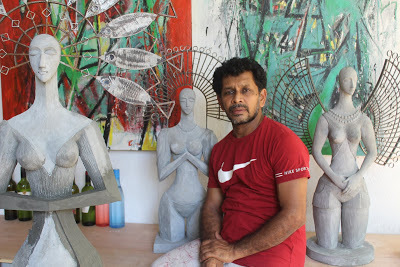
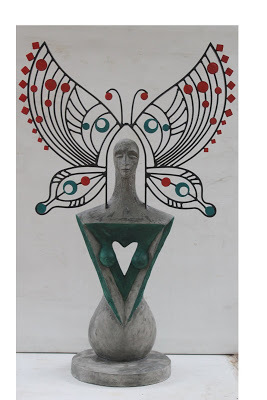
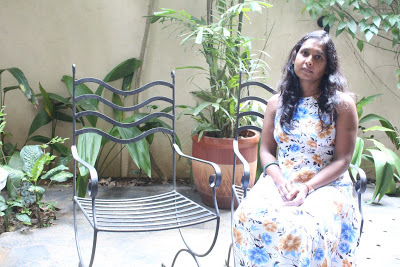
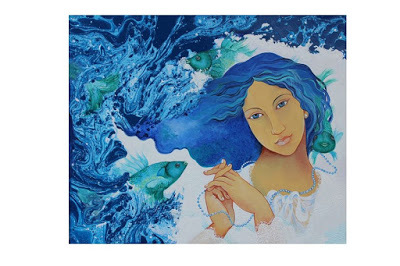
Sri Lankan artist Dr Manoranjana Herath talks about his work and that of his wife Dilini Perera during a visit to Kochi
Pics: Manoranjana Herath; 'Princess of My World'; Dilini Perera; her work
By Shevlin Sebastian
On a recent morning, Sri Lankan artist Dr. Manoranjana Herath steps back from a 4’ tall sculpture, made of cement and iron, he has just completed at his studio in Colombo. It shows a bald-headed woman with her hands clasped together in front of her. She has large butterfly-type wings attached to her shoulder. This is the seventh in a series called ‘Princess Of My World’. “This series is to show my appreciation of women,” says Herath, who is a senior lecturer at the University of Visual and Performing Arts. “They also have a desire to fly and achieve their dreams. But many times, they have to face obstacles and tragedies.”
“I do abstract paintings, too,” says Herath, who had come to Kochi before the lockdown.
The abstract works were inspired by Herath’s visit in August, last year to the Sinharaja Forest Reserve, a UNESCO World Heritage Site in Southern Sri Lanka. Owing to the monsoon rains, he could feel the sodden leaves under his feet. The air was crisp, and there was a canopy of vivid green. The twitter of birds added to the sense of tranquility that he felt.
“When you observe Nature closely, you can see uncommon patterns, shapes, colours, rhythms and textures,” says Herath. “I tried to reproduce that on the canvas. I have also used the original prints of leaves and applied some colour on it. What I want to say is that we are all part of Nature. So, we have to protect it.”
Herath’s wife Dilini Perera is also an artist. In one work, she has drawn a dusky-skinned woman, with blue eyes, large flowers in her blue hair, and wearing a pearl necklace, against a backdrop of water, with fishes in it. “An acrylic on canvas, this is a poetic version of a woman,” says Herath, whose wife did not come to Kochi. “Dilini does stylistic images. So far, she has held two exhibitions and many group shows.”
The couple met in college, fell in love, got married in 2000, and have two sons, Akalanka, 18 and Aloka, 13. Asked whether it is difficult for two artists to live together, Herath smiles and says, “We get along very well. There is a better understanding because of our mutual passion for art.”
However, Herath is frank enough to say there is not much of an audience for art in Sri Lanka. “For the inauguration of any exhibition, there will be only 30 to 40 people present,” he says. “And most of them will be friends of the artist.”
Herath came to Kochi at the invitation of his friends Girish Kalleli and Lekha Vylopilly. “Two years ago, I had asked Lekha, ‘Can we do something?’ And that has borne fruition now,” says Herath. “I love to travel. Artists should always meet new people and places. But this is the first time I am coming to Kerala.”
Asked about the impact of the two-decade-long civil war on the sensibilities of artists, Herath says, “There are a few artists who still focus on the sufferings borne by the people. For me, the war is history. I don’t want to hurt people through my work. People are suffering everywhere. So I don’t want them to feel depressed when they come for an exhibition.”
As for the relations between the different communities, Herath says, “Many people only see through the lens of their religion or community. Then it becomes a problem. Some people talk about how the Sinhalese are the majority, while the Muslims and Tamils belong to the minority. As an artist, I believe we are all human beings. There is a common humanity. So we should accept everybody. Once upon a time, we had lived peacefully with each other. I hope that day will return.”
(Published in The Kochi Post)
Published on May 15, 2020 19:59
May 13, 2020
Love in a bakery
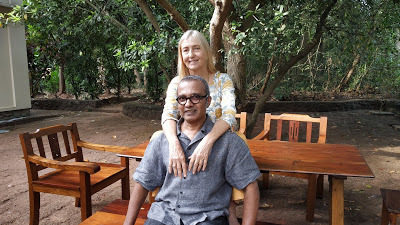

Mohammed Rafi met Susanne in Kerala and fell in love. Nearly 30 years later, it is still going strong. They talk about their relationship in these times of rising divorce rates
Pics: Mohammed Rafi and Susanne; Noah Harith
By Shevlin Sebastian
The dog comes up. Then he carefully sniffs at the visitor. Behind the dog -- a Staffordshire bull terrier -- the brick-red house shines in the morning sunlight. On the verandah is a wooden table, at one side. Glasses are filled with lime juice. The couple sit with a smile on their faces. Mohammed Rafi runs a bakery in Shoranur town. His wife, Susanne, who is from Cologne, Germany is a farmer. The land is just behind the house. She grows organic rice, vegetables, mangoes, coconuts, and bananas.
The couple’s love story began in the 1980’s. Susanne had come to the Kerala Kalamandalam, at Cheruthuruthy, three kilometres from Shoranur, to do a Carnatic singing course.
Every now and then, she, along with a few friends, would stop at a bakery to have pastries and soft drinks. Sitting at the cash counter was Rafi. He was instantly attracted to Susanne. The German, on the other hand, did not notice him at all.
Later, Rafi befriended a French couple, who were friends with Susanne. “That’s how I connected with Susanne,” says Rafi.
But while Rafi did not speak German, Susanne did not speak English very well. “But we had a wordless connection,” says Susanne. One day, Rafi proposed. Susanne said, “I will take you to Germany, so that you can see where I come from,” she told him.
In late 1989, he flew with Susanne to Germany. Susanne’s mother Lilo taught German to Rafi. He began to speak to Susanne. They developed an understanding. And on September 6, 1990, they had a registered marriage in Germany.
For the honeymoon they went to the Spanish island of Mallorca. “It was a beautiful time,” says Rafi. “We hired a two wheeler and travelled around the island. At that moment we were always together.”
In 1993, their only child Noah was born.
As to why they named their son Noah, Susanne says, “Because I knew since the past 30 years that the world is going downhill, owing to climate change, the word which has become so fashionable now. Noah is about the Ark who rescues all the animals, and I love animals.”
In 1996, they returned to Kerala. Rafi took over the bakery which had been run by his late father. The couple have been living in Kerala ever since.
In front of their house, in the distance, two white houses can be seen. One belongs to the couple’s 26-year-old son Noah Harith, a professional biker, while the other is Susanne’s studio. She is a painter.
Asked to list his positive points, Susanne says, “I think too much. Sometimes, this is a burden. Then I will consult Rafi and he will give me a short and appropriate answer. I like that. We are together but we live independent lives. He is busy with his shop and I am busy with my farm. It is good. But when there is a need, Rafi is always there. We have developed a deep understanding.”
As for Rafi, he was initially attracted by her glowing blonde hair. “Then when I got friendly with her, I liked her character,” he says. “She is honest and transparent.”
Meanwhile, over two decades, Susanne has noticed that Kerala has changed. “Earlier, there would be one car in a day,” she says. “Now there are thousands. The people blow their horns and make a lot of noise. The inner quietness is gone.”
Thanks to a consumer boom, there is a frenzy of buying. “This desire is always present in the minds of the people,” says Susanne. “I miss the earlier simplicity. In the West development took time. So they had the time to mentally digest what was happening. In India things have moved very fast thanks to the influence of the media.”
But what Susanne loves about Kerala is the way babies are treated. “There is always physical contact. The mother, relatives, siblings and grandparents are always holding the child,” she says. “This is one reason why India, with all its problems, is still holding together. There is a base of love and confidence in every person. On the other hand, in Germany, the baby is left alone. Maybe because both parents are working, or there is nobody to help. There is not that nearness.”
She pauses and says, “In the end, there are pluses and minuses in both countries. I cherish the best aspects of both.”
(Published in The Kochi Post)
Published on May 13, 2020 03:14
May 5, 2020
Lending a helping hand
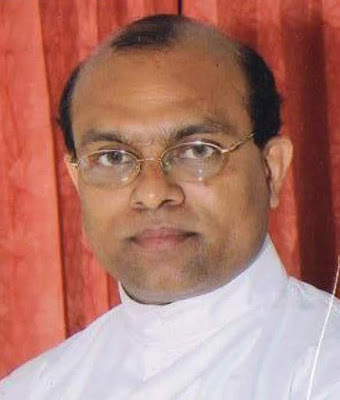
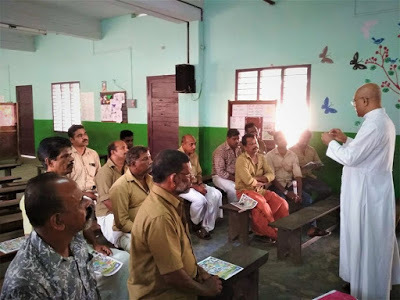
For 20 years, Sarathi has been looking after the needs of autorickshaw drivers in Kerala
Photos: Dr Fr Sebastian Thekkanath; a meeting in progress
By Shevlin Sebastian
The grocery kits are ready. In each, there is one kilo of sugar, wheat, pulses, gram, vegetable oil, and packets of different types of masala. There is no rice since the Kerala State government had already distributed 30 kilos of rice free to those below the poverty line and 15 kilos for those above. Now, these kits are also being distributed free, owing to the coronavirus lockdown, at the autorickshaw stand in the town of Angamaly (40 kms from Kochi). Supervising it is the Sarathi organisation, which celebrated its 20th anniversary on March 11.
Sarathi's main aim is to look after the needs of taxi and autorickshaw drivers. “We felt that they were a segment that did not get much respect from society,” says Dr Fr Sebastian Thekkanath, the state director of the organisation, which is under the aegis of the Justice, Peace and Development Commission of the Kerala Catholic Bishops’ Council.
Very early in his interactions Fr. Sebastian saw that many of the drivers had taken loans, for emergency expenses, from private money lenders at high rates of interest. So, he came up with a suggestion. Members of each auto stand should open a bank account. And they should strive to put Rs 300 every week in the account. That would work out to Rs 1200 a month or Rs. 14,400 a year. Money could be withdrawn to a maximum of 95 per cent of the deposited amount. “This way, they did not have to pay high-interest rates,” said Fr. Sebastian.
Now and then Sarathi also conducts motivational classes to improve the character and personality of the drivers.
The organisation’s reputation has been spreading. There are 28,457 members across 14 districts. They belong to all castes and religions. “Everybody is welcome,” says Fr Sebastian.
And the members are happy. Nawas MN has been president of the Sarathi unit at the Lisie Hospital stand at Kochi for the past three years. Out of 42 auto drivers, 34 are members of Sarathi. “I used to work in a union, and because of political opposition no work used to get done for the members," he said. "But in Sarathi we are all united.”
The drivers put money into a common bank deposit. And two years ago, they bought an autorickshaw costing Rs 1.6 lakh for their colleague Prafulla Chandran. He is repaying in monthly installments. The Lisie unit also pays the motor and medical insurance of its members. They have also donated Rs 1 lakh to charity. For a poor lady who has to undergo regular kidney dialysis, the unit has paid her bills.
However, the biggest gain for Nawas was that he has been able to change his behaviour towards customers. “It is only after I joined Sarathi I realised that we have a poor image in society,” he says.
Many customers will agree. Whenever PR professional Susan Thomas, 35, travels in an auto in Kochi, she ends up in an argument over the fare with the driver. “They are always overcharging,” she says, a flash of anger erupting in her eyes. “None of them follow the meter. They are so rude.”
Fr Sebastian admits that many drivers are boorish and domineering and overcharge a lot. But he says there are reasons for this. “Let’s take a stand where there are 40 autos standing one behind the other,” he says. “By the time the 40th auto gets a passenger, two hours have passed. But the 40th customer may want to travel for two kms. So, the driver can only charge the minimum rate of Rs 25. Sometimes, they have four trips in a row of minimum charges. That is Rs 100 only, till about 2 p.m.”
So when they get a trip which has a fare of Rs 100, they will immediately charge Rs 150, to make up for the poor income earlier. However, this will anger the customer. “I don’t condone their behaviour,” says Fr Sebastian. “It is cheating. But they feel compelled to ask for a higher fare.”
Many of them have taken bank loans to buy the vehicle. So, there is the monthly EMIs, household, educational and medical expenses. There are additional payments for auto repairs, fuel and their daily food bills, as many live outside the towns, so they cannot go home for lunch.
“In Sarathi, we hold classes where we tell them it is important to behave courteously with passengers and to be honest in their dealings,” says Fr. Sebastian.
Since many of the drivers have to wait a long time at the stand, Fr Sebastian tells the auto drivers to use the time constructively. Drivers are encouraged to keep the area neat and clean, by using a broom, render assistance to old people who are about to cross the road or read books and newspapers. “We also encourage the drivers to collect plastic packets in the area and take it to recycling plants,” says Fr. Sebastian. “This could be their contribution to a cleaner environment.”
Unfortunately, many go through a tough time because of a polluted environment. “Most drivers suffer from dust allergy because they are always on the road,” says Fr. Sebastian. “Their lungs are damaged by excessive pollution. Many have shoulder and back problems because of the constant use of the gear and leg pedals.” Recently, a 46-year-old had to stop driving his vehicle because of excessive back pain. He had been a driver for over 20 years. On his doctor’s advice, he has left the profession.
Owing to their low status in society, family members are not proud of their bread-winner. But during annual meets, where families are invited, Sarathi shows the important contributions that a driver makes.
“If there is an accident, it is always an autorickshaw which is used to transport the injured to the hospital,” says Fr. Sebastian. “Drivers have saved so many lives. And when you cannot find a location, most people ask the local autorickshaw driver for directions. If they take their job seriously they can prevent drug peddlers from operating in an area. And when they are standing in a particular area, they can keep a watch on unusual movements of people in the locality.”
Fr. Sebastian gives an example. Two years ago, there was a stand next to a school in Kochi. One day a driver saw a 14-year-old girl go out of the school and enter a church nearby. Many people use the toilets even though they may not be church members. So, this girl entered the ladies toilet in her school uniform and when she came out, she was in a white T-shirt, blue jeans and high heels. She reached the road and got onto a bike driven by a boy.
So, one autorickshaw driver followed the bike, while his colleagues informed the school principal who called the parents. As a result, within half an hour, the girl was located and brought back. “We can never say what could have happened,” says Fr. Sebastian. “Maybe, there would have been no problems at all or the girl could have fallen into a trap.”
(Published in The Kochi Post)
Published on May 05, 2020 01:13
April 29, 2020
And then the tranquility got shattered
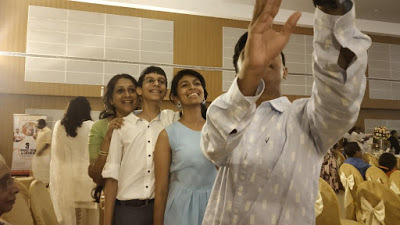
By Shevlin Sebastian
At 11 p.m., on a Saturday a few weeks ago, I was cruising down National Highway No 47 in Kochi. Elton John’s ‘Circle of Life’ was playing on the music system.
The mood inside the car was tranquil. My daughter Sneha had just landed from Bangalore and so my wife and teenage son, along with I, had gone to collect her from the airport. She is doing her first year in college. Dressed in jeans and a cream blouse-top, and blue sneakers, she smiled happily as she entered the car.
The conversation began. Sneha spoke about the quality of the food in her hostel, her roommates, lecturers, classmates, and the latest movie she had seen. My son, two years younger, sitting next to her on the back seat, listened silently.
The highway was relatively deserted: a few trucks and some cars. Kochi sleeps early: the metro service, besides the pillars of which we were travelling, had closed. And so were the private bus services. An occasional long-distance Kerala State Road Transport Corporation bus trundled past, with its distinctive red and yellow colours.
I was driving at 50 kms per hour as we were in no hurry and I was listening to what my daughter was saying rather than concentrating on the road.
Children grow up so fast. It seemed only the other day that I held Sneha in my arms. And now she was all grown up. When she was in Class 12, I remembered the large birthday card, almost the size of an A 3 size chart, that some of her classmates had made in which they did drawings and wrote greetings, using red, green, blue and purple felt pens.
However, one comment from a boy made me stop breathing for a few moments. ‘You have a nice ass’, he wrote. It took me some time to digest that. And accept. My daughter was a sexual being to her male contemporaries.
In the car, Sneha suddenly asked, “Baba, do you mind if I put my music on?”
“Sure,” I said. And she leaned forward and pressed a cable wire into the socket of the music system and her mobile. Soon, her songs started to play. The first one was Selena Gomez’s haunting ‘Lose you to love me’.
Incredibly, I had heard it the day before. I read an article about the song and decided to hear it on YouTube. In her song, Selena was indirectly commenting on her failed romance with pop superstar Justin Bieber. Sneha was shocked and impressed when I told her all this.
“Baba, you are in touch,” she said, with a smile.
“Just a fluke,” I said, modestly.
She hummed the first few lines:
‘You promised the world and I fell for it
I put you first and you adored it
Set fires to my forest
And you let it burn’
All of a sudden, a red Maruti Suzuki car swerved in from an outer lane and cut in front of me. I instinctively half-pressed the brake and dropped my speed to 40 kms/hour. The other car moved ahead. I was wondering about why the driver felt the need to cut in. There were three lanes on our side. He could have easily gone straight ahead. I thought: ‘Is the driver drunk, high on drugs or slept off for an instant?’ I could see a few heads in the car.
Inexplicably, a few moments later, it swerved violently to the right and hit a pillar of the Kochi Metro at high speed. The thud sounded like a thunderbolt. All of us looked through the windscreen with bulging eyes and open mouths. I braked as a black piece, probably a part of the bumper, ricocheted away and came to a stop just in front. I quickly moved the vehicle to the left, without looking at the rear-view mirror. Thankfully, there was no vehicle behind us. I parked on one side.
Inside the stricken car, there was no movement for several moments.
Sneha suggested that I call the police. I pulled out my mobile and did so. By the time I passed all the relevant information to the helpline, including the number of the metro pillar where the accident took place, a crowd had gathered. When I reached the damaged car I saw that the two white airbags in front had burst open. That probably explained why the driver, a thin man with curly black hair, had escaped with just a cut on his upper lip. He looked to be about 22, and stood to one side, with blank eyes, as if he could not see.
Somebody said, “Did you sleep off suddenly?” He quickly shook his head and said, “No, I lost control.” Somebody asked whether it was a brake failure. He shook his head. Was he drinking? The reply was a tightening of his jaws.
A woman, who was in the back seat, was pulled out gently by a few bystanders, with her husband cradling her head. She was laid down on the road -- a middle-aged lady in a green salwar kameez. From the look on her face -- the eyeballs almost vanishing as the lids closed -- she was rapidly losing consciousness. There were two children, a boy and a girl, both below ten years of age. They stood nearby staring at their mother.
Soon, a car which was going past was stopped by several people, with raised arms and shouts. Again the woman was carried to the back seat, men holding her arms and legs, and somebody placed his palms under her back to balance her. The husband put his children on both his knees, as he sat in the front seat, next to the driver. They headed to the nearest hospital.
Meanwhile, drivers, who were going past, slowed down, slid their window panes down, and stared with frozen eyes at the shattered engine. Where the bonnet had been smooth, now it was all crumpled metal. Ten minutes later, the police arrived.
Some passers-by expressed the hope the woman would be okay.
A couple of days later I called the Kalamassery police station under whose jurisdiction the accident had taken place. A policeman said that the woman had been declared brain-dead on her arrival at the hospital. The doctors put her on the ventilator. They informed the husband. He spoke to his family members. They agreed there was no point. Two days after the accident, the ventilator was switched off. And she passed away. She was only 37 years old and worked in the administration section of a government hospital in Kochi itself. It seemed she hit her forehead on the back of the front seat with great force, and this proved to be fatal.
From the time the driver lost control to hitting the pillar was all of two seconds. That was the minuscule time taken for a tragedy to take place.
So, why did this event take place? Why did God take the mother away from the children at such a crucial stage in their lives? What will be the psychological blow on them? Who can replace their irreplaceable mother? Nobody, I guess. How will the husband handle the situation of being both father and mother? As strangers, we will never know the answers.
Meanwhile, when we set out again, there was a tomb-like silence in the car. Everybody stared straight ahead, lost in their thoughts. My wife told me later that Sneha had been deeply affected, especially when she came to know that the woman had died.
So, what to make of it when a fortnight later Sneha was involved in a two-wheeler accident in Bangalore. She was travelling behind a classmate on a scooter on a Sunday morning. They took a right turn, a car came speeding up, hit them and sped away. My daughter was flung onto the pavement. She had scratches on her face, arms, elbows and knees.
Sneha called us from the hospital. My wife shed tears but she quickly regained control. We decided to leave immediately. At that time, there were no flights. The runway at Kochi airport was being recarpeted. So, the flights were only in the early mornings or at night.We took a train to Salem and then a bus. By the time we reached it was 11 p.m.
Thankfully, a relative’s wife, a homoeopathic doctor, had handled matters. She went to the hospital, got my daughter discharged and took her to a better hospital. An X-ray revealed a crack in her pelvic bone. The healing had to be natural. A two-month rest was advised by the doctor. So, we brought her back to Kochi. Sadly, she missed many classes.
I did wonder how much of seeing the first accident played a role in my daughter getting involved in an accident of her own? Who knows how the mind works? The subconscious is a mystery.
In retrospect, I wished that we had not seen the accident.
When asked what he feared the most as Prime Minister, the late Harold Macmillan said, “Events, dear boy, events.”
Indeed, this seems to be right.
The repercussions of an event can lead one to sunlight or darkness.
(Published in the Borderless Journal.com)https://borderlessjournal.com/…/and-then-the-tranquility-…/…
Published on April 29, 2020 23:08
April 19, 2020
Running In These COVID times

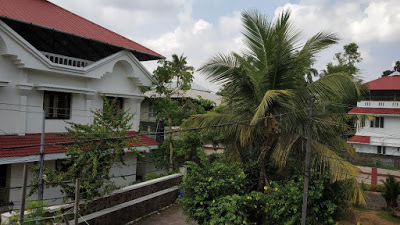
By Shevlin Sebastian
Pics: Jogging illustration; middle-class houses in Kochi
Every day, at 6 p.m., I set out from my home in Kochi for a run. In these coronavirus times, I have marked out a route that runs parallel to the main road. For a few days, the cops, in khaki uniform, were stopping cars and two-wheelers but they left the individuals alone.
I have started running after a decade. During those years, I was swimming. But the pool, where I swim, is closed. The lifeguard has gone home. The club is shuttered. There is a lone watchman in a blue uniform standing at the gate and saying, “Nobody is here.”
In my mid-fifties, it takes time for my body to move. The legs are stiff, and the arm movements are negligible. But around 300 meters into my run, a miracle happens. My body shakes off the lethargy, my legs start moving rhythmically, and soon I am gliding across the road. A younger version has taken over. Or maybe, my muscle memory has asserted itself.
It is a beautiful route. There are large trees with overhanging branches on either side.Most houses have lawns in front where red and white roses are grown. In some homes, there are vegetable patches at the back. In the concrete jungle of Mumbai, you may have to pay crores of rupees to enjoy this. But in Kochi, these are the houses of middle-class people. How lucky we are.
Over the rasping of my breath, through my open mouth, I can hear birdsong. No longer is auto and car horns, and the groaning exhaust of ill-maintained lorries the dominant sound. When I run I no longer have to look at the road, as no vehicles are coming from the opposite direction, just a stray white dog who looks at me with mournful eyes as if asking, ‘Where have all the people gone?’
But they are there, inside their houses, and outside too.
I see a woman picking up a large blue bedsheet from a clothesline on the terrace of her house. I see a thirty-something woman, in a white nightgown, standing at the door, holding a sleeping baby, with a white headscarf, in her arms, and looking curiously at me. On another terrace, a woman is watering her plants, placed on the parapet, a row of red pots, using a green hose. ‘Nice colour contrast,’ I think.
But on this April summer day, with more than 95 per cent of humidity, the perspiration starts to drip down my forehead. My breath is rushing out, like water from a burst pipe, through my open mouth. Incredibly, at this moment, I think of my mother.
Last night, when I went to meet her, she said she was thinking of her father. She said the entire family had gone to the St. Alphonsa Pilgrim Centre at Bharananganam (75 km from Kochi). “My father was about to fall into a deep pit, which was hidden under a canopy of weeds,” she said. “But at the very last moment, he bent and saw it. He said that St. Alphonsa had saved him.”
It is a big family -- many brothers and sisters. Three have passed away. Her parents are both dead. Their house has become a private college. Where my grandfather used to sit in a low armchair, a short, squat man, with silver hair and a bald brown patch at the top of his head, in a large hall, where the ticktock of a large black clock on the wall could be heard clearly, now college students come and listen, with drooping eyes, to the drone of a teacher, who looks bored and sounds listless. He’s been teaching the same syllabus for decades.
As my mother spoke, I realized that she is an orphan. She can never meet her parents anymore except in her imagination. And in a matter of years, I will be an orphan too, as my father is now 93 and my mother is 83. What would life be like without parents? A friend, who lost his parents, told me that you think of them more when they have passed away than when they are alive.
I run faster and expectedly I can feel a pain in my lungs, as my body tells me to slow down. And so I do.
I am depressed. I have lost my job in the print media, and my 38-year career seems to have come to an end. What do I do now? Owing to the virus, the economy is at a standstill. And so am I.
I have a daughter and a son in college. Early marriage but late parenthood. Two miscarriages roiled my wife’s equanimity. But finally, after nine years of marriage, and treatments at various fertility centres, God nodded and the babies came. But now, how do I pay my bills, their bills, our bills? Thankfully, my wife has a good job as a counsellor in a college. So, we won’t starve.
Unfortunately, we have a bitter-sweet marriage. The pattern is one week of sweetness followed by three weeks of sourness. This pattern has continued for a long time. “You are too self-absorbed,” she said. “I can’t handle it.”
We have been married for 27 years.
I agree with her. All writers go inside themselves all the time. You lose touch with the outside. You lose awareness of people and their emotional needs. Which woman likes that?
Since I have slowed down, my breath, through my wide-open mouth, has begun to go in and out easier. One day, there will be the last breath. Which day, month and year will it be? At what time? How old will I be? Who will be around me? Will I be in a hospital room all alone? Will my children be far away? In another country? Will they have any affection left for me?
And if my wife is still around, and if she is staring at me, by my bedside, as I get ready to leave the planet, will it be a bittersweet moment for her: sad that I am dying but happy for some crumbs of freedom after I am buried -- free at last, free at last, thank God Almighty I am free at last.
And nobody will point fingers at her, which might have happened if we had divorced. These accusations could have been shouted at her by relatives or our children. But this is the smoothest way to freedom. The bugger died. Not my fault.
I feel my legs starting to move smoothly again. I think this is a second wind. If I want, I can stop. But I know I can continue if I keep going in this steady manner. Now my body has become like a machine. Of course, it is an ageing machine.
It was my friend Anup Singh who introduced me to running. I was a frail boy with black-framed spectacles, who liked to read books all the time. A nerd. He lived two buildings away on a street beside a large park in Calcutta. I don’t know how we first met, but we were in our teens. He was 6’ and I was 5’ 5”. And he had a passion for tennis. He played it every day at a club inside the park. And to keep fit, he would go for runs on the perimeter of the park. He urged me to come with him.
“I have never run before,” I said. There is always a first time, he said. So I asked my parents to buy me a pair of white keds, and they gladly did so. They did not like me staying cooped up inside the house all the time. A shy boy with no friends.
But when I started running, it was a revelation. I had a smooth style. Always, from the very beginning, I felt that I was gliding over the ground. “Man, you are good,” said Anup, who showed a thumbs-up to me. There was a reason for his appreciation. He ran in a heavy lumbering way. Of course, he was 80 kgs and this weight proved a hindrance. It came as no surprise that through the decades, he never liked running.
But I am sure he likes his present-day life a lot. He is a tennis coach at a millionaires’ club in Florida. Through shrewd real-estate deals and stock investments, Anup has made a pot of money. He lives in a gated community that has a clear lake, an amber-blue swimming pool, a well-equipped gym and a gleaming black Mercedes Benz in his garage. But he has stayed in touch with me. Calls once a month. Has retained his Indian accent and simplicity. When in the mood, both of us speak in Bengali, as a nostalgic tribute to our Calcutta roots. A Rajput and a Malayali speaking in Bengali. That’s the beauty of a syncretic India, now under furious attack by fundamentalists who are unwilling to accept that the people they demonise have a soul just like them.
I am running steadily now. Three elderly men, in white and multi-coloured lungis, stand around, keeping the social distancing norms (Kerala has the highest literacy rates in India, so they know the rules) and chat about the hot weather. I go past. They pause to look at me. They might make comments about me after I have gone some distance away. It does not worry me at all. But what I am worried about is the state of my knees.
A decade ago, fearful that my knees would take a hit since I was always running on tarred roads, I shifted to swimming. And this turned out to be even better than running. Gliding through the water, every muscle getting a workover, especially the lower back, always a point of weakness for sedentary workers, the sense of rejuvenation I felt when I stepped out of the pool after a 45-minute session. There was nothing to match it. My brain became soaked in dopamine.
And the moment my head hit the pillow, I was out, like a knockout blow to the chin by a professional boxer.
But now, in the times of the virus, I have to rely on the good old legs but the dopamine that seeps out is a trickle, like the flow of water in a river during the middle of a drought. Still, something is better than nothing. Be happy.
In the end, I stop running and take out my handkerchief and wipe my face and neck. And keep wiping it as the sweat continues to flow. I walk and walk, till I finally reach my home....an oasis as well as a battlefront.
(Published in Borderless Journal)
https://borderlessjournal.com/2020/04/20/notes-from-kerala-running-during-covid/
Published on April 19, 2020 22:58
March 21, 2020
A surfeit of feminine voices


Malayalam author Sethu’s first novel in English, ‘The Cuckoo’s Nest’ is about a house for helpless girls run by a former nun
By Shevlin Sebastian
One of the surprises when you pick up ‘The Cuckoo’s Nest’ by author Sethu, his first English novel, is the foreword. It is written by none other than Sr. Jesme, who wrote the best-seling 'Amen', the life of a nun in Kerala. But then it no longer becomes a surprise when you realise one of the main characters is Madam Agatha, a former nun who runs a home for troubled girls from all over the country.
But Sethu clarifies that he had not read Sr. Jesme’s ‘Amen’ when he wrote the book, which has been published by Niyogi Books. However, he was aware of the troubles faced by her and other nuns in their daily life because of the widespread coverage in the media. “Maybe, the impact was unconscious,” he says. However, Sethu received a compliment when Sr. Jesme called him up, after reading the novel and said, “This is my story.”
In the foreword Sr. Jesme writes, ‘Sethu has imbibed the nuances of a woman’s mind who has left the convent life and is to be commended for creating a character like Madam Agatha. She has transformed herself from a religious entity into a secular personality.”
This is true. Because, very early in the novel, Agatha says, “This is not an orphanage run by the mothers or a madhom run by the swamis. I had never asked you about your religion or caste, Neither did I listen to your private prayers to find out your religion. Your prayers are nothing but your attempt for a private communication with the Almighty.”
She also told the inmates that there should be no loud prayers or chanting of bhajans of any community in the open hall. If one wanted they could do so privately in their room, without disturbing the peace of others. This would be a secular space and only those who believe in secularism and tolerance should join.
And Sethu had a specific reason to focus on these subjects. “It is to highlight the situation the country is going through,” he says. “This is my first socio-political novel.”
At the ‘Cuckoo’s Nest’, there is a procession of girls from all over India, like Sabeena, Parveen Singh, and Ranjini, who are suffering from various psychological issues and running away to get some mental peace.
Asked why he attempted a novel in English, Sethu says, “It was an adventure or you can call it a misadventure.”
What is interesting to know is that Sethu studied in a Malayalam-medium school in the village of Chendamangalam. “I did not learn English properly,” he says. “What I know is acquired English. When I was writing ‘The Cuckoo’s Nest’, over six months, I often consulted the dictionary as well as a thesaurus.”
Many of the characters are composites. What helped was that thanks to his more than four-decade-long working career Sethu has worked in Maharashtra, Tamil Nadu, Punjab, Madhya Pradesh, Delhi, Andhra Pradesh and Karnataka. And during his career, Sethu has met a wide variety of people. “I am also comfortable with the languages and cultures of these places,” says Sethu, who retired in 2005 as chairman and managing director of the South Indian Bank.
The reviews from readers have been positive. Says Moumita Roy: “The story idea is unique and fresh. The character of Madam Agatha is well researched. The scenario of the plot is relatable with current India. The story has been narrated nicely. I enjoyed reading it.”
And Sethu is also enjoying his 55th year as a writer. He has published 35 novels and short story collections. Among the many prizes he has won is the Kendra Sahitya Akademi Award, the Kerala Sahitya Akademi Award as well as the Vayalar Award. “It has been a long journey,” says the 78-year-old with a smile.
(The New Indian Express, Kochi and Thiruvananthapuram)
Published on March 21, 2020 00:34
March 20, 2020
Kerala priest remembers encounters with Nirbhaya convicts
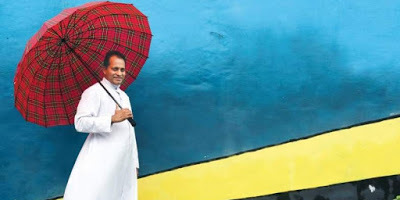
By Shevlin Sebastian
Fr. John Puthuva was working as a counsellor in Tihar Jail from 2012-15. So, during his work, he met many prisoners including the Nirbhaya killers, Mukesh Singh, Vinay Sharma, Pawan Gupta and Akshay Thakur. They had brutally raped and murdered a 23-year old physiotherapy intern on a moving bus. All of them wore head covers, with slits, as they went for hearings during their trial at a fast-track court in mid-2013. Fr John would meet them on their return, offer words of consolation and tell them to pray to God for forgiveness. The police constables listened quietly.
Later, inmates assaulted Mukesh and he was kept in solitary imprisonment for his safety.
Once, the priest, along with a couple of volunteers went to Ravidas camp, a slum in RK Puram, South Delhi to meet up with Mukesh’s family. But they were refused access. However, when they made another attempt, they were allowed to meet the slum dwellers as well as the neighbours because they identified themselves as social service workers. “The local people told me that what they did was a horrendous crime,” says Fr John. “They knew the men had to be punished.”
But Fr. John, who is now the parish priest of the St. George’s Church in Kalady, has his reservations about the hanging of Mukesh, Vinay, Pawan and Akshay, which took place in the early hours of March 20. “I believe God gives us life, so we have no right to take a human life,” he says. “Instead, exemplary punishment should have been given.”
(The New Indian Express, Kochi)
Published on March 20, 2020 01:19
March 19, 2020
Snapshots of the present

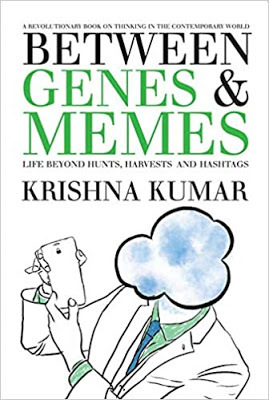
Author Krishna Kumar, in his book, ‘Between Genes and Memes’ writes perceptively about the impact of social media, the lack of critical thinking and the fear of missing out
By Shevlin Sebastian
In his book, ‘Between Genes and Memes’, Kochi-based HR consultant Krishna Kumar says, “Look at a chicken’s life. From the beginning of its life to the time it reaches 40 days, it is fed every day. Every single feeding firms up the bird’s belief that it is the natural rule of life to be fed every day by friendly members of the human race. And then, one day, something unexpected happens, which revises its entire belief system. On the 40th day, it reaches maximum safety when the risk, in fact, the highest.
“Tailspin: A farm chicken, which always feared the hunter dogs in the courtyard, finally gets eaten by the owner, master and guardian.”
The 228-page book, published by Recto and Verso and available on Amazon and Kindle, is filled with nuggets of wisdom on every page. The chapter headings include, ‘Reputation makes you a slave’, ‘What meditation, marathons, music and marijuana can do for you’, ‘How clickbait articles consume half of our lives’ and ‘Facts tell, stories sell’.
In ‘stories sell’, Krishna says, “Humans think in stories. Not in data. We aspire to be rational but 80 percent of our decisions are irrational. We are driven by emotions, and not by logic. It requires a lot of willpower to drive decisions based on logic. It is like swimming against the tide. It is hard. In the new economy, companies claim their decision-making is driven by insights from data analytics, but ultimate decisions are based on biases, emotions and fears. That is utterly human. So, it is important to learn the art of story-telling.”
Nine years ago, Krishna began writing on Facebook. Then he moved to Twitter and Linkedin. He adopted a contrarian stand. Soon, he began to get readers. They responded to what he wrote. “They told me they are aware of the idea but the way I say it is different,” says Krishna.
However, one day, his sister said, “You can impress with snippets. But can you show me how good you are, with a 2000-word blog.”
Krishna took up the challenge. Initially, he found it very tough. His thoughts would go haywire. There was no logic or structure. But slowly, he learnt how to write.
Recently, web developer Limi Joseph told Krishna that his blog was not secure, and there should be a back-up. Krishna agreed. The back-up was done. And the 300 posts were sent to him in a single word document. As Krishna re-read his posts, he had a mixed reaction. “Some of the posts embarrassed me, while some surprised me,” he says. “Some were instant deletes.” And slowly it dawned on him that he could make a book. But he says that it needed his editor Joshy Mathew’s skills to get the book into a coherent shape.
At a coffee shop in Kochi, his mind wanders over a wide array of subjects. At one point, he bemoaned the lack of importance given to philosophy. “People are practical these days,” he says. “If you ask a friend to define success, he will define it in terms of money and possessions. He will not think much of people who have found meaning in life and may have had a deep contribution in various sectors but it cannot be measured. But philosophy can lead to wisdom. It is more valuable than knowledge.”
And, he says that this ceaseless consumption of byte-sized information through the mobile phone has become an addiction. “We are in a constant state of FOMO: fear of missing out,” he says. “It creates restlessness. We are afraid of being with ourselves.”
It has also damaged the brain. “There is no critical thinking or analysis,” says Krishna. “People read news from five different sources, but there is no analysis. The hurry to give opinions results in snap judgements. And it may not be right, too.”
(The New Indian Express, Kochi)
Published on March 19, 2020 00:22
March 18, 2020
India’s first woman superstar
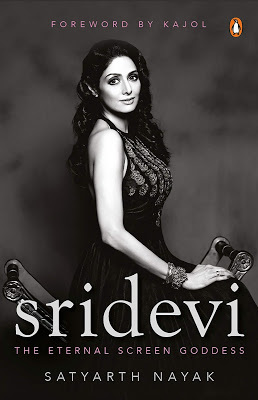

In his well-written and engaging biography, author Satyarth Nayak decodes the reasons behind actor Sridevi’s stupendous success over five decades
Photos: The book cover; author Satyarth Nayak
By Shevlin Sebastian
One day after the film ‘Roop Ki Rani Choron Ka Raja’ (1993) was released, actor Sridevi, as well as her future husband Boney Kapoor, who was the film’s producer, were travelling in a car at Mumbai. In the front seat, beside the driver, sat the film’s director Satish Kaushik.
Satish turned, looked at Boney and said, “Sir, what is the box office collection of the first day?” With a budget of Rs 7 crore, it had been the most expensive film ever made.
Boney said, “The film has crashed.”
Satish broke down because it was his debut film as director.
Suddenly Satish felt a hand on his back. And when he turned he saw that it was Sridevi. The superstar consoled Satish by saying, “It’s alright. Don’t worry. Such things happen. It is not your fault.”
Satish was touched by Sridevi’s gesture. “She had delivered a big flop, and I was responsible for that,” he says. “And yet she was consoling me. It takes a very big heart to behave like that.”
This anecdote is recounted in the well-written and engaging biography ‘Sridevi - The Eternal Screen Goddess’ by the Mumbai-based author Satyarth Nayak.
Asked the reasons why he decided to write the book, Satyarth says, “She was India’s first female superstar. Sridevi was the only actress who was No 1 in Hindi, Tamil and Telugu. She was also the only actress who made a successful comeback after a 15-year hiatus, following her marriage and motherhood with ‘English Vinglish’ (2012). And, lastly, there was the prolific career: 300 films in five languages.”
The book moves forward chronologically with chapter headings like ‘Little Star’, ‘Teen Heroine’, ‘Deccan Diva’, ‘Bombay Bombshell’, ‘Reel Regina’, ‘Indian Goddess’, ‘Last Empress’ ‘Homeward Bound’, and ‘Comeback Czarina’.
As for the reasons why she became such a big star, Satyarth says, “She was very versatile as an artist. Sridevi could do comedy, tragedy, and drama very well. She was also a very good dancer.”
Actor Kajol, in the foreword, suggests a few more reasons. “Sridevi knew which script would work and which wouldn’t,” she writes. “She had the pulse of the audience at all times. She knew the camera so well -- how it would shoot her, which was the best angle. She paid attention to the minutest of details. And her eyes spoke volumes.”
And along the way, she had a big impact, especially on women. “Sridevi did comedy so well, there was a fearlessness in her that empowered women,” says Satyarth. “They realised they could just be themselves instead of being prim, proper and ladylike.” She also challenged patriarchy, sexism and fought for wage parity in Bollywood.
Another unintended impact was on the LGBT community. In her career, Sridevi played many double roles. This dichotomy appealed to the LGBT community where they have a public persona as well as a private one. “So, they could easily identify with her on-screen,” says Satyarth. The biggest impact on the community was through the film ‘Nagina’ (1986) where Sridevi plays a snake who masquerades as a human being.
Finally, Satyarth deals at length with the sudden and inexplicable drowning of the star in a bathtub at the Jumeirah Emirates Towers in Dubai, on February 24, 2018, at the age of 54. Numerous conspiracy theories were bandied about, as well as allegations of murder. But Satyarth says, “It is all rubbish.”
After Sridevi’s death, Satyarth spoke to Boney Kapoor, South superstar Nagarjuna and Pankuj Parashar, the director of ‘Chalbaaz’. “All three told me Sridevi suffered from low blood pressure,” says Satyarth. “Nagarjuna told me that they were shooting a Ram Gopal Varma film ‘Govinda Govinda’ (1993). One day as they waited for Sridevi to come to the set, they heard she had fainted in the bathroom.”
Pankuj said that when they were shooting for the film, ‘Meri Biwi Ka Jawab Nahin’ (2004), on one occasion, Sridevi had again fainted in the bathroom. “She battled low blood pressure for a long time,” says Satyarth. “There were several instances when she had collapsed. Boney Kapoor said sometimes when they were walking together, she would fall. What might have happened was that when she got into the tub, at her suite in Dubai, she might have fainted and drowned.”
(The Sunday Magazine, New Indian Express, South Indian editions and in Delhi)
Published on March 18, 2020 04:11
March 15, 2020
The story of Indian migration

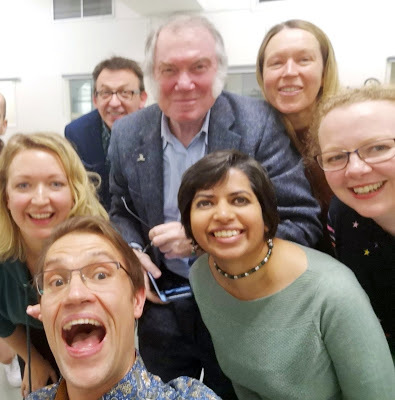
Author Shreya Sen-Handley is the first Indian woman to write an epic poem for the Welsh National Opera
Photos: Shreya Sen-Handley; with the members of the Wales National Opera
By Shevlin Sebastian
On the morning after her return from attending a literary festival in Kolkata sometime ago, author Shreya Sen-Handley opened her email and got a shock. There was a message by Sir David Pountney, the director of the Welsh National Opera. He told Shreya they are staging an opera called ‘Migrations’, to celebrate the 400th anniversary of the Mayflower crossing, when the British went to America for the first time on the Mayflower ship. But they also wanted a contribution from her to focus on the Indian migration to the UK. For about five minutes, Shreya was in shock. Then she Google searched to check whether Sir David was a hoax. But it turned out that he was indeed the director. So Shreya said yes and got cracking.
In the end, she wrote an epic poem titled, ‘This is the life!’ “There are two central Indian characters, doctors Jai and Neera who had been invited by the British government to come across to help build the National Health Service,” says Shreya. “They were promised a wonderful life. But when they came they were treated badly, and were doing longer hours than everybody else and getting less pay.”
During that time, in 1968, there were anti-immigration riots in London. Two white people who had gone on a march landed up at the hospital with injuries because of a scuffle. “The Indian doctors had to treat the racists,” says Shreya. “But following successful treatment, there is a realisation among the whites that the Indians are worthy members of their society. So, there is a rapprochement at the end.”
As to how the poem is used, Shreya says, “The composer Will Todd has set it to music, and he is working with Sir David and the ‘Migrations’ team to produce it for the stage. Every word written for an opera is sung, unlike musical theatre where some of it is said than sung.” There will be Bollywood-style dances, British-Indian singers and instruments like the sitar and the tabla will be used.
The premiere is to be held on October 3, at the Wales Millennium Centre which is the home of the Welsh National Opera. Prince Charles is the head of the institution. “There is a good chance he will attend,” says Shreya. Thereafter there will be six performances in different venues in Birmingham, Plymouth, Bristol and Southampton, and the run will conclude on November 28.
For the two-hour long event, there will be one hundred people in the cast and another hundred in the three different choirs, apart from a full live orchestra. And to her surprise, Shreya realised that she is in exalted company. Only two other Indians have received similar invitations to contribute to an opera -- Amit Chaudhuri and Jeet Thayil. “I am perhaps the first Indian and South Asian woman to write for a major opera,” she says. “I feel thrilled.”
Shreya is a multi-talented person. Apart from poetry, she does book cover illustrations for major English publishers in India and Britain. HarperCollins has recently published her second book, a collection of short stories called ‘Strange’, which legendary author Ruskin Bond described as ‘masterful’. “All the stories have unexpected endings,” says Shreya. “It is a mix of science fiction, dystopia, fantasy, comedy, horror and romance.” Her earlier book was called ‘Memoirs of my body’.
She is also a columnist for many newspapers and magazines in India and teaches creative writing at Cambridge and Nottingham universities. Shreya was a director of the Nottingham Festival of Literature and is a governor of schools. She is also a regular commentator on current affairs for the BBC, Notts TV, and other media. Married to a Briton, she has two children and has been living in Britain since 2000.
Shreya also belongs to a family which has a notable heritage. Her paternal grandfather Satyabrata Sen worked in the United Nations and was also an advisor to the late Prime Minister Rajiv Gandhi as well as the Kerala government. Her mother is the great grand-niece of the spiritual philosopher Sri Aurobindo. A great-great-grandfather was Ramananda Chatterjee, the editor of the Modern Review, who published articles by Mahatma Gandhi, Rabindranath Tagore and Jawaharlal Nehru. “Many regard him as the father of Indian journalism,” says Shreya. “So writing is in my blood.”
Published on March 15, 2020 23:17



